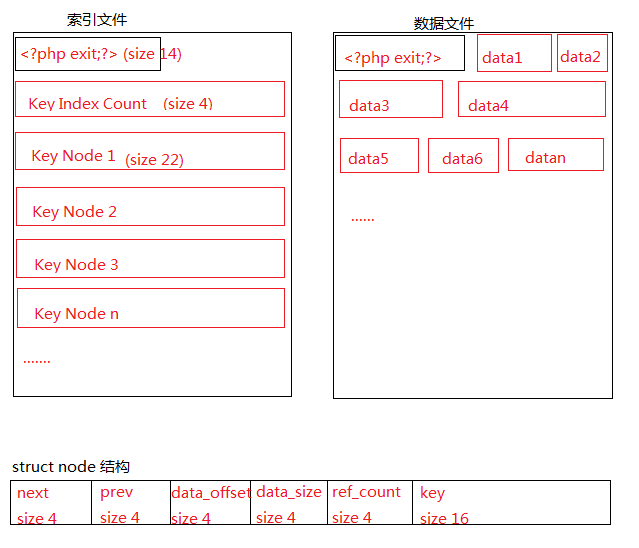PHP开发网络通信、文件存储中经常需要交换数据,为了减少网络通信流量、文件存储大小以及加密通信规则,经常需要对数据进行双向加解密以保证数据的安全。 PHP中实现此功能主要需要使用的函数主要是pack及unpack函数 pack 压缩资料到位字符串之中。
语法: string pack(string format, mixed [args]...); 返回值: 字符串 本函数用来将资料压缩打包到位的字符串之中。
a - NUL- 字符串填满[padded string] 将字符串空白以 NULL 字符填满 A - SPACE- 字符串填满[padded string] h – 十六进制字符串,低“四位元”[low nibble first] (低位在前) H - 十六进制字符串,高“四位元”[high nibble first](高位在前) c – 带有符号的字符 C – 不带有符号的字符 s – 带有符号的短模式[short](通常是16位,按机器字节顺序) S – 不带有符号的短模式[short](通常是16位,按机器字节排序) n -不带有符号的短模式[short](通常是16位,按大endian字节排序) v -不带有符号的短模式[short](通常是16位,按小endian字节排序) i – 带有符号的整数(由大小和字节顺序决定) I – 不带有符号的整数(由大小和字节顺序决定) l– 带有符号的长模式[long](通常是32位,按机器字节顺序) L – 不带有符号的长模式[long](通常是32位,按机器字节顺序) N – 不带有符号的长模式[long](通常是32位,按大edian字节顺序) V– 不带有符号的长模式[long](通常是32位,按小edian字节顺序) f –浮点(由大小和字节顺序决定) d – 双精度(由大小和字节顺序决定) x – 空字节[NUL byte] X- 后面一个字节[Back up one byte](倒回一位)
unpack
解压缩位字符串资料。
语法: string pack(string format, mixed [args]...); 返回值: 数组
本函数用来将位的字符串的资料解压缩。本函数和 Perl 的同名函数功能用法完全相同。
案例一、pack实现缩减文件数据存储大小
语法: string pack(string format, mixed [args]...); 返回值: 字符串 本函数用来将资料压缩打包到位的字符串之中。
a - NUL- 字符串填满[padded string] 将字符串空白以 NULL 字符填满 A - SPACE- 字符串填满[padded string] h – 十六进制字符串,低“四位元”[low nibble first] (低位在前) H - 十六进制字符串,高“四位元”[high nibble first](高位在前) c – 带有符号的字符 C – 不带有符号的字符 s – 带有符号的短模式[short](通常是16位,按机器字节顺序) S – 不带有符号的短模式[short](通常是16位,按机器字节排序) n -不带有符号的短模式[short](通常是16位,按大endian字节排序) v -不带有符号的短模式[short](通常是16位,按小endian字节排序) i – 带有符号的整数(由大小和字节顺序决定) I – 不带有符号的整数(由大小和字节顺序决定) l– 带有符号的长模式[long](通常是32位,按机器字节顺序) L – 不带有符号的长模式[long](通常是32位,按机器字节顺序) N – 不带有符号的长模式[long](通常是32位,按大edian字节顺序) V– 不带有符号的长模式[long](通常是32位,按小edian字节顺序) f –浮点(由大小和字节顺序决定) d – 双精度(由大小和字节顺序决定) x – 空字节[NUL byte] X- 后面一个字节[Back up one byte](倒回一位)
unpack
解压缩位字符串资料。
语法: string pack(string format, mixed [args]...); 返回值: 数组
本函数用来将位的字符串的资料解压缩。本函数和 Perl 的同名函数功能用法完全相同。
案例一、pack实现缩减文件数据存储大小
此时test.txt的文件大小是10byte。注意此时文件大小是10字节,实际占用空间大小是1KB。
上面存储的整数实际是以字符串形式存储于文件test.txt中。 但如果以整数的二进制字符串存jy储,将会缩减至4byte。
案例二、数据加密 以字符串形式存储一段有意义数据,7-110-abcdefg-117。 字符"-"分割后,第一位表示字符串长度,第二位表示存储位置,第三位表示实际存储的字符串,第四位表示结尾位置。
上述方法缺点: 一、数据存储大小 二、数据以明文方式存储,如果是任何敏感信息,都可能造成不安全访问。 三、文件存储大小,以不规则方式递增。
加密:
存储一段数据,加密格式为:整数2位长度字符串10位长度整数1位长度。 优点: 一、数据大小最优化 二、在不知道"i2a7i1"这样的压缩格式时,即使拿到文件,也无法正确读出二进制文件转化为明文。 三、数据增加时,文件存储大小是等量递增。每次都是以19byte递增。
案例三、key-value型文件存储 存储生成的文件为两个:索引文件,数据文件 文件中数据存储的格式如下图:代码实现:
_node_struct = array( 'next'=>array(1, 'V'), 'prev'=>array(1, 'V'), 'data_offset'=>array(1,'V'),//数据存储起始位置 'data_size'=>array(1,'V'),//数据长度 'ref_count'=>array(1,'V'),//引用此处,模仿PHP的引用计数销毁模式 'key'=>array(16,'H*'),//存储KEY ); $this->_file_index_name = $file_index; $this->_file_data_name = $file_data; if(!file_exists($this->_file_index_name)){ $this->_create_index(); }else{ $this->_file_index = fopen($this->_file_index_name, "rb+"); } if(!file_exists($this->_file_data_name)){ $this->_create_data(); }else{ $this->_file_data = fopen($this->_file_data_name, "rb+");//二进制存储需要使用b } } //创建索引文件 private function _create_index(){ $this->_file_index = fopen($this->_file_index_name, "wb+");//二进制存储需要使用b if(!$this->_file_index) throw new fileCacheException("Could't open index file:".$this->_file_index_name); $this->_index_puts(0, '<'.'?php exit()?'.'>');//定位文件流至起始位置0, 放置php标记防止下载 $this->_index_puts($this->_file_header_size, pack("V1", 0)); } //创建存储文件 private function _create_data(){ $this->_file_data = fopen($this->_file_data_name, "wb+");//二进制存储需要使用b if(!$this->_file_index) throw new fileCacheException("Could't open index file:".$this->_file_data_name); $this->_data_puts(0, '<'.'?php exit()?'.'>');//定位文件流至起始位置0, 放置php标记防止下载 } private function _index_puts($offset, $data, $length=false){ fseek($this->_file_index, $offset); if($length) fputs($this->_file_index, $data, $length); else fputs($this->_file_index, $data); } private function _data_puts($offset, $data, $length=false){ fseek($this->_file_data, $offset); if($length) fputs($this->_file_data, $data, $length); else fputs($this->_file_data, $data); } /** * 文件锁 * @param $is_block 是否独占、阻塞锁 */ private function _lock($file_res, $is_block=true){ flock($file_res, $is_block ? LOCK_EX : LOCK_EX|LOCK_NB); } private function _unlock($file_res){ flock($file_res, LOCK_UN); } public function add($key, $value){ $key = md5($key); $value = serialize($value); $this->_lock($this->_file_index, true); $this->_lock($this->_file_data, true); fseek($this->_file_index, $this->_file_header_size); list(, $index_count) = unpack('V1', fread($this->_file_index, 4)); $data_size = filesize($this->_file_data_name); fseek($this->_file_data, $data_size); $value_size = strlen($value); $this->_data_puts(filesize($this->_file_data_name), $value); $node_data = pack("V1V1V1V1V1H32", ($index_count==0) ? 0 : $index_count*$this->_inx_node_size, 0, filesize($this->_file_data_name), strlen($value), 0, $key); $index_count++; $this->_index_puts($this->_file_header_size, $index_count, 4); $this->_index_puts($this->get_new_node_pos($index_count), $node_data); $this->_unlock($this->_file_data); $this->_unlock($this->_file_index); } public function get_new_node_pos($index_count){ return $this->_file_header_size + 4 + $this->_inx_node_size * ($index_count-1); } public function get_node($key){ $key = md5($key); fseek($this->_file_index, $this->_file_header_size); $index_count = fread($this->_file_index, 4); if($index_count>0) { for ($i=0; $i < $index_count ; $i++) { fseek($this->_file_index, $this->_file_header_size + 4 + $this->_inx_node_size * $i); $data = fread($this->_file_index, $this->_inx_node_size); $node = unpack("V1next/V1prev/V1data_offset/V1data_size/V1ref_count/H32key", $data); if($key == $node['key']){ return $node; } } }else{ return null; } } public function get_data($offset, $length){ fseek($this->_file_data, $offset); return unserialize(fread($this->_file_data, $length)); } } //使用方法 $cache = new fileCache(); $cache->add('abcdefg' , 'testabc'); $data = $cache->get_node('abcdefg'); print_r($data); echo $cache->get_data($data['data_offset'], $data['data_size']);
案例四、socket通信加密 通信双方都定义好加密格式: 例如:$LOGIN = array( 'COMMAND'=>array('a30', 'LOGIN'), 'DATA'=>array('a30', 'HELLO') ); $LOGOUT = array( 'COMMAND'=>array('a30', 'LOGOUT'), 'DATA'=>array('a30', 'GOOD BYE') ); $LOGIN_SUCCESS = array( 'COMMAND'=>array('a30', 'LOGIN_SUCCESS'), 'DATA'=>array('V1', 1) ); $LOGOUT_SUCCESS = array( 'COMMAND'=>array('a30', 'LOGIN_SUCCESS'), 'DATA'=>array('V1', time()) );
服务器端与客户端根据解析COMMAND格式,找到对应的DATA解码方式,得到正确的数据
收藏的用户(0) X
正在加载信息~
推荐阅读
最新回复 (0)
站点信息
- 文章2313
- 用户1336
- 访客11737860
每日一句
Grow through what you go through.
穿越困境,得以成长。
穿越困境,得以成长。
新会员
